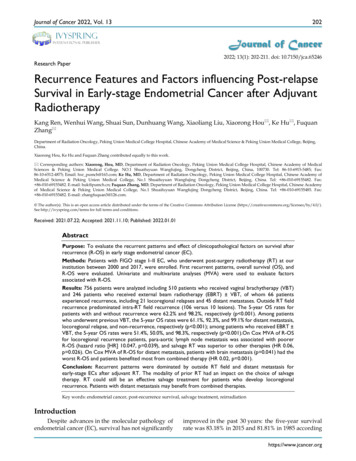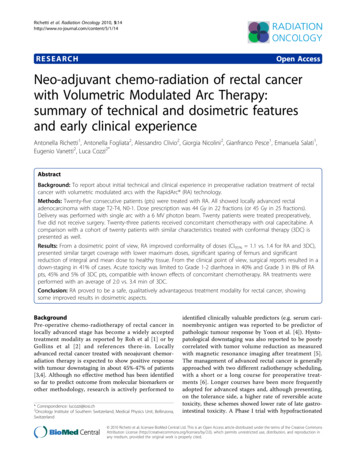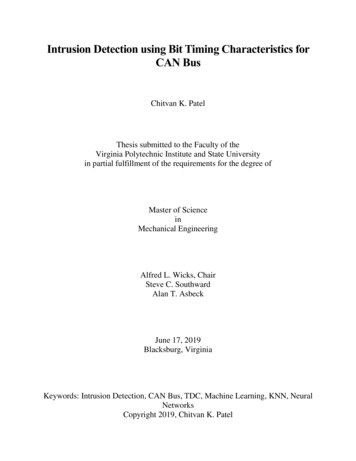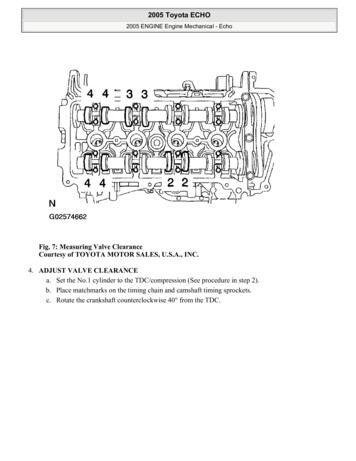
Transcription
Gao et al. BMC Cancer (2018) EARCH ARTICLEOpen AccessImpact of timing of adjuvant chemotherapyon survival in stage III colon cancer: apopulation-based studyPeng Gao1†, Xuan-zhang Huang1,2†, Yong-xi Song1, Jing-xu Sun1, Xiao-wan Chen1, Yu Sun1, Yu-meng Jiang1and Zhen-ning Wang1*AbstractBackground: There is no consensus regarding the optimal time to initiate adjuvant chemotherapy after surgery forstage III colon cancer, and the relevant postoperative complications that cause delays in adjuvant chemotherapyare unknown.Methods: Eligible patients aged 66 years who were diagnosed with stage III colon cancer from 1992 to 2008were identified using the linked Surveillance, Epidemiology, and End Results-Medicare database. Kaplan-Meieranalysis and a Cox proportional hazards model were utilized to evaluate the impact of the timing of adjuvantchemotherapy on overall survival (OS).Results: A total of 18,491 patients were included. Delayed adjuvant chemotherapy was associated with worse OS(9–12 weeks: hazard ratio [HR] 1.222, 95% confidence interval [CI] 1.063–1.405; 13–16 weeks: HR 1.252, 95% CI 1.041–1.505; 17 weeks: HR 1.969, 95% CI 1.663–2.331). The efficacies of adjuvant chemotherapy within 5–8 weeks and 4 weeks were similar (HR 1.045, 95% CI 0.921–1.185). Compared with the non-chemotherapygroup, chemotherapy initiated at 21 weeks did not significantly improve OS (HR 0.882, 95% CI 0.763–1.018).Patients with postoperative complications, particularly cardiac arrest, ostomy infection, shock, and septicemia, had asignificantly higher risk of a 4- to 11-week delay in adjuvant chemotherapy (p 0.05).Conclusions: Adjuvant chemotherapy initiated within 8 weeks was acceptable for patients with stage III coloncancer. Delayed adjuvant chemotherapy after 8 weeks was significantly associated with worse OS. However,adjuvant chemotherapy might still be useful even with a delay of approximately 5 months. Moreover, postoperativecomplications were significantly associated with delayed adjuvant chemotherapy.Keywords: Colon cancer, Stage III, Timing of adjuvant chemotherapy, Postoperative complications, SEER-MedicareprogramBackgroundColon cancer is an important cause of cancer-related incidence and mortality and remains a major public healthproblem worldwide [1]. The current clinical practiceguidelines from the National Comprehensive CancerNetwork (NCCN) and the European Society for MedicalOncology (ESMO) recommend adjuvant chemotherapy* Correspondence: josieon826@sina.cn†Equal contributors1Department of Surgical Oncology and General Surgery, The First Hospital ofChina Medical University, 155 North Nanjing StreetHeping District, ShenyangCity 110001, People’s Republic of ChinaFull list of author information is available at the end of the articlefollowing surgical resection as a standard treatment forpatients with stage III colon cancer because of the benefit of chemotherapy in reducing the risk of recurrenceand death by eradicating micrometastases [2].Several studies have reported that the surgical resection of a primary tumor might induce angiogenesis andproliferation of dormant micrometastases by releasinggrowth-stimulating factors and triggering immunosuppression that leads to tumor growth [3–7]. Moreover,Harless et al. reported that the effectiveness of adjuvantchemotherapy was inversely proportional to the timefrom adjuvant chemotherapy initiation to surgical The Author(s). 2018 Open Access This article is distributed under the terms of the Creative Commons Attribution 4.0International License (http://creativecommons.org/licenses/by/4.0/), which permits unrestricted use, distribution, andreproduction in any medium, provided you give appropriate credit to the original author(s) and the source, provide a link tothe Creative Commons license, and indicate if changes were made. The Creative Commons Public Domain Dedication o/1.0/) applies to the data made available in this article, unless otherwise stated.
Gao et al. BMC Cancer (2018) 18:234resection [8]. Therefore, it is a reasonable hypothesisthat there may be a time-dependent cut-off point aftersurgery after which the benefit of adjuvant chemotherapy is not significant because of the failure to eradicatemicrometastases. However, the NCCN and ESMOguidelines do not specify an optimal time to initiate adjuvant chemotherapy after surgical resection. Most clinical trials of adjuvant chemotherapy in colon cancerrequire adjuvant chemotherapy initiation within 6 to8 weeks after surgical resection [9–12]. Routine preclinical and clinical data suggest that adjuvant chemotherapyin colon cancer should be initiated earlier rather thanlater, but, in real practice, the initiation of adjuvantchemotherapy in colon cancer is often delayed [13, 14].There is no direct and high-quality evidence regardingthe importance of the timing of adjuvant chemotherapyin colon cancer. Although two meta-analyses demonstrated that delays in the initiation of adjuvant chemotherapy were detrimental to survival in colorectal cancer[15, 16], these meta-analyses included both rectal andcolon cancer, and it was thus not clear whether the conclusions could be applied to the treatment of colon cancer because of the biological differences between coloncancer and rectal cancer. To date, few retrospectivestudies evaluated the impact of the timing of adjuvantchemotherapy on survival in colon cancer, and the results were inconsistent [17–23]. Moreover, the relevantpostoperative complications that cause delays in adjuvant chemotherapy are unknown.Therefore, this population-based study was conductedto assess the impact of the timing of adjuvant chemotherapy on survival in stage III colon cancer and to assess whether postoperative complications wereassociated with the timing of adjuvant chemotherapy.MethodsData sourceThis study was conducted utilizing the Surveillance, Epidemiology, and End Results (SEER) program andMedicare-linked databases. The SEER program is a comprehensive source of population-based data on patientdemographics, tumor characteristics, cancer-relatedtreatments, and causes of death that covers approximately 28% of the population of the United States [24].The Medicare database contains individual health insurance claims for approximately 97% of the populationaged 65 years in the United States and complementsthe SEER with diagnoses, cancer-related treatments, andoutcomes. In the Medicare database, Part A provideshealth-insurance data about hospitals, skilled-nursing facilities, hospices, and home health care, and Part B provides data about physician and outpatient services [25,26]. The SEER-Medicare database was described in ourprevious study [27].Page 2 of 15The access to the SEER-Medicare database was approved by National Cancer Institute and InformationManagement Services, Inc. (D6-MEDIC-821), and thisstudy was approved by the Institutional Review Board ofthe First Hospital of China Medical University.Study populationThis study included eligible patients aged 66 years fromSEER-Medicare database who were diagnosed with primary colon adenocarcinoma from 1992 to 2008 (SEERcancer site codes 18.0, and 18.2 to 18.9). The participating patients fulfilled the American Joint Committee onCancer (AJCC) staging criteria for stage III colon cancerand underwent primary tumor resection with curativeintent within 180 days of diagnosis. The adjuvantchemotherapy regimens were 5-fluorourcil (5-FU)/capecitabine alone or 5-FU/capecitabine plus oxaliplatin(FOLFOX/CapeOX). The non-chemotherapy group included patients with no record of chemotherapy withinone year of surgery. The FOLFOX/CapeOX group included patients with any record of 5-FU/capecitabineplus oxaliplatin within 4 weeks of their first chemotherapy dose.The exclusion criteria were the following: (1) patientswho previous non-colon cancer or a diagnosis of noncolon cancer within 1 year of the colon cancer diagnosis,(2) those with incomplete pathological stage entries ordiagnostic data, (3) those who received adjuvant chemotherapy only after tumor relapse or metastasis, (4) thosewho received preoperative neoadjuvant treatments orother adjuvant chemotherapy regimens, (5) those whodied within 30 days of diagnosis, and (6) those lackedfull coverage from Medicare Parts A and B from12 months before diagnosis to 9 months after diagnosisor were enrolled in a health maintenance organization.The National Drug Codes for the drugs and the HealthCare Financing Administration Common ProcedureCoding System have been previously reported [27].Study variablesWe obtained the patient demographics from the SEERpatient entitlement and diagnosis summary file, including gender, age at diagnosis, race, marital status, residence location, household income, education level, andyear of diagnosis. The disease characteristics, includingprimary tumor site (right-side or left-side colon), histologic grade (well differentiated, moderately differentiated, or poorly differentiated/undifferentiated), histologictype (adenocarcinoma, mucinous carcinoma, or signetring cell carcinoma), tumor stage, presence of preoperative obstruction or perforation, and number of examinedlymph nodes ( 12 or 12) were also studied. The tumorstage was assessed based on the seventh edition of theAJCC TNM staging system [28, 29]. The time to the
Gao et al. BMC Cancer (2018) 18:234initiation of adjuvant chemotherapy was defined as theinterval between the curative surgery and the administration of the first chemotherapy.For the evaluation of the comorbidities, we used theHierarchical Condition Category (HCC) risk score tosummarize the health care problems and predict the future health care cost of the population compared withthe average Medicare beneficiary (HCC 1.0), and theHCC risk score was derived from the Medicare inpatientand outpatient claims for various comorbidities within12 months before the colon cancer diagnosis [30]. Thepostoperative complications were identified by assessingthe discharge diagnoses within 1 month of surgery.Statistical analysisFor the descriptive analysis, the categorical variableswere compared using χ2 tests and the continuous variables were compared using the Mann-Whitney U tests.In the univariate analysis of survival, Kaplan–Meier survival curves for overall survival (OS) were generated according to the chemotherapy regimen and timing ofadjuvant chemotherapy, and these curves were compared using log-rank tests. A spline-based hazard ratio(HR) curve with the corresponding confidence limitswas used to evaluate the effect of the continuous covariate of interest (i.e., the timing of adjuvant chemotherapy)on the outcome (OS) [31, 32]. Multivariate Cox proportional hazards models were used to determine the relationships of multiple survival-related variables withsurvival.All statistical analyses were conducted using SAS version 9.3 (SAS Institute, Cary, NC, USA), STATA version12.0 (Stata Corporation, College Station, TX, USA), SPSSversion 18.0 (SPSS, Inc., Somers, NY, USA), and R version 3.1.1 (R Foundation for Statistical Computing,Vienna, Austria). For all analyses, a two-sided p-value ofless than 0.05 was considered statistically significant.Page 3 of 15The patient profiles and disease characteristics are presented in Table 1.Overall comparison of the timing of chemotherapyWe used a spline-based HR curve to explore the impactof the timing of adjuvant chemotherapy on overall survival in patients with stage III colon cancer. The resultsindicated that a minimum risk of mortality was achievedat 4 weeks after surgery, and the survival benefits decreased with a delay in the timing of adjuvant chemotherapy of more than 4 weeks (Fig. 1). Therefore, weused the value of 4 weeks as a reference for the survivalanalysis, and the results of univariate analyses indicatedthat delayed chemotherapy was significantly associatedwith worse OS (9–12 weeks: HR 1.169, 95% confidenceinterval [CI] 1.019–1.341, p 0.026; 13–16 weeks: HR 1.237, 95% CI 1.031–1.483, p 0.022; 17 weeks:HR 2.207, 95% CI 1.870–2.604, p 0.001). However,chemotherapy that was initiated within 5–8 weeks aftersurgery did not significantly increase the risk of mortality (HR 0.982, 95% CI 0.867–1.113, p 0.780). AKaplan–Meier survival curve that was stratified by thetiming of chemotherapy is presented in Fig. 2. Multivariate Cox proportional hazards models produced resultssimilar to those of the univariate analyses (5–8 weeks:HR 1.045, 95% CI 0.921–1.185, p 0.498; 9–12 weeks:HR 1.222, 95% CI 1.063–1.405, p 0.005; 13–16 weeks: HR 1.252, 95% CI 1.041–1.505, p 0.017; 17 weeks: HR 1.969, 95% CI 1.663–2.331, p 0.001,Table 2). Moreover, the survival benefit of adjuvantchemotherapy was statistically insignificant when adjuvant chemotherapy was initiated 21 weeks after resection compared with the non-chemotherapy group (HR 0.882, 95% CI 0.763–1.018, p 0.087, Fig. 3), andchemotherapy initiated 25 weeks after surgery did notelicit an OS benefit compared with the nonchemotherapy group (HR 1.019, 95% CI 0.863–1.204,p 0.821, Fig. 3).ResultsPatient characteristicsA total of 18,491 patients with stage III colon cancerwho underwent surgical resection between 1992 and2008 were identified using the SEER-Medicare database.Among these, 8058 patients received 5-FU or capecitabine alone, 1664 patients received FOLFOX, and 8769patients did not receive adjuvant chemotherapy. Withrespect to the timing of adjuvant chemotherapy, 746 patients received adjuvant chemotherapy within 4 weeksafter surgery, 6165 patients received adjuvant chemotherapy within 5–8 weeks after surgery, 1883 patients received adjuvant chemotherapy within 9–12 weeks aftersurgery, 466 patients received adjuvant chemotherapywithin 13–16 weeks after surgery, and 462 patients received adjuvant chemotherapy 17 weeks after surgery.Comparison of the timing of FOLFOX/CapeOXchemotherapyOur results indicated that the survival benefit fromFOLFOX/CapeOX chemotherapy was more evidentthan that from 5-FU alone in patients with stage IIIcolon cancer (HR 0.615, 95% CI 0.555–0.683, p 0.001, Fig. 4), although both chemotherapy regimenssignificantly improved the OS (p 0.001) comparedwith the non-chemotherapy group. Therefore, the relationship between the timing of FOLFOX/CapeOXchemotherapy and OS was further evaluated. The results of the multivariate analysis indicated that FOLFOX/CapeOX chemotherapy that was initiated within5–8 weeks did not increase the risk of mortality compared with FOLFOX/CapeOX chemotherapy that was
Gao et al. BMC Cancer (2018) 18:234Page 4 of 15Table 1 Clinicopathologic features of patients subjected todifferent chemotherapy 1243591799Female56454467865GenderTable 1 Clinicopathologic features of patients subjected todifferent chemotherapy regimens ll43242299Moderate536051691046Poor Undifferentiated2756225148622121633Histologic gradeAge at diagnosis, tologic type76–8017842180419Adenocarcinoma740268111425 8054291630147Mucinous carcinoma12161140212Signet-ring cell carcinoma15110727736969091407RaceWhitepT pT4b80036972Marital statusSingle Separated823551125Married310546201044pN categoryDivorced 28892750554pN2a15501518357Big Metro48024219878pN2b1015892253Metro or Urban29632853588pTNM stageLess Urban or Rural1002986198pTNM IIIa673920190pTNM IIIb6239581411321st quartile22031803371pTNM IIIc185713243422nd quartile210219763753rd quartile206219493934th quartile20352029443Unknown367301821st quartile206420034012nd quartile20292015373HCC risk score3rd quartile213619204004th 997–2000167818870 122001–200427393169240 122005–2008251511001424Residence locationMedian household incomeLevel of educationPreoperative intestinal e intestinal perforationNo857679981648Yes19360161st quartile255718112894082nd quartile16852427539823rd quartile197221954924th 651639Yes7729325066086Year of diagnosisPrimary tumor siteright-sided colon586751111068left-sided colon27302809572unknown17213824Number of examined lymph nodePostoperative radiotherapyTiming to AC 4 weeks
Gao et al. BMC Cancer (2018) 18:234Page 5 of 15Table 1 Clinicopathologic features of patients subjected todifferent chemotherapy regimens ��8 weeks0511810479–12 weeks0150238113–16 weeks036997 17 weeks040953No-chemo876900Abbreviation: AC Adjuvant chemotherapy, HCC Hierarchical ConditionCategories; No-chemo, without adjuvant chemotherapy, 5-FU 5-fluorouracil,FOLFOX/CapeOX 5-FU/capecitabine plus oxaliplatininitiated 4 weeks after surgery (HR 1.009, 95% CI 0.619–1.644, p 0.971, Table 3). However, FOLFOX/CapeOX chemotherapy initiated within 9–12, 13–16,and 17 weeks tended to produce worse OS (9–12 weeks: HR 1.640, 95% CI 0.990–2.717, p 0.055;13–16 weeks: HR 1.422, 95% CI 0.788–2.566, p 0.243; 17 weeks: HR 2.482, 95% CI 1.354–4.549,p 0.003, Table 3). Indeed, the spline-based HR curvefor FOLFOX/CapeOX chemotherapy indicated thatthe survival benefit of FOLFOX/CapeOX chemotherapy was not statistically significant when it was initiated at 19 weeks compared with the nonchemotherapy group (HR 0.672, 95% CI 0.441–1.024, p 0.064, Fig. 5).Postoperative complications and the timing ofchemotherapyWe examined the correlation of postoperative complications with the delayed initiation of adjuvant chemotherapy. The results indicated that patients withpostoperative complications had a significantly higherrisk of delayed adjuvant chemotherapy (p 0.05;Fig. 6). Among the postoperative complications, cardiac arrest (19.50 vs. 8.22 weeks; Δ 11.28 weeks), ostomy infection (14.60 vs. 8.22 weeks; Δ 6.38 weeks),shock (13.69 vs. 8.18 weeks; Δ 5.51 weeks), andsepticemia (12.02 vs. 8.13 weeks; Δ 3.89 weeks) hadstrong influences on chemotherapy delay with a delayof approximately 4–11 weeks. Additionally, disruptionof the operation wound (Δ 3.11 weeks), peritonitis(Δ 3.07 weeks), fistula of the gastrointestinal tract(Δ 2.97 weeks), acute renal failure (Δ 3.34 weeks),postoperative infection (Δ 2.85 weeks), intestinalperforation (Δ 2.02 weeks), acute myocardial infarction (Δ 1.88 weeks), and stroke (Δ 1.96 weeks)could result in delays in the initiation of adjuvantchemotherapy of approximately 2–3 weeks. In turn,hemorrhage, pneumonia, urinary infection, pulmonaryembolism, respiratory disease, gastrointestinal disorder, anemia, vein disease, gastrointestinal disease,nausea and vomiting, and obstruction had relativelyweak impacts on the chemotherapy delay (a delay ofFig. 1 Splines-based hazard ratio curve for identification of the effect of timing of chemotherapy on overall survival. The solid line presents therelationship (log hazard ratio) between timing of chemotherapy and overall survival, and the dotted line presents the corresponding 95%confidence limits
Gao et al. BMC Cancer (2018) 18:234Page 6 of 15Fig. 2 Kaplan–Meier curve of the timing of chemotherapy and overall survival. The p value is derived from log-rank test for the overall comparison ofoverall survival between different timing of chemotherapy and non-chemotherapy groupapproximately 0.5–1.5 weeks), although the differences were significant.DiscussionThere is no evidence about the optimal time to initiate adjuvant chemotherapy after surgical resection,or whether there is an ideal timing for adjuvanttherapy after which treatment benefit decreases. Thispopulation-based study based on the SEER-Medicaredatabases was conducted to evaluate the relationshipbetween the timing of adjuvant chemotherapy andsurvival in stage III colon cancer. The results indicated that adjuvant chemotherapy that was initiatedwithin 5–8 weeks after surgery did not increase therisk of mortality compared with chemotherapy initiated at 4 weeks after surgery, and the initiation ofadjuvant chemotherapy within 8 weeks after surgerywas thus feasible. However, adjuvant chemotherapyafter 8 weeks of surgery was significantly associatedwith worse OS. The survival benefit of adjuvantchemotherapy became statistically insignificant whenchemotherapy was initiated after 21 weeks comparedwith the non-chemotherapy group, thus, adjuvantchemotherapy might be still useful even with a delayof approximately 5 months (Fig. 3). Our resultsindicated that the survival benefits of the FOLFOX/CapeOX chemotherapy regimen within 5–8 weeksand 4 weeks were similar, and chemotherapy initiated 19 weeks did not have a significant OS benefitcompared with the non-chemotherapy group.The favorable effect of adjuvant chemotherapy onsurvival primarily involves the eradication of residualdisease and micrometastases. However, the relationship between the timing of adjuvant chemotherapyand survival is unclear. Several studies reported thatprimary tumor removal could accelerate angiogenesisand growth of residual disease and micrometastasesby releasing growth-stimulating factors and promotingimmunosuppression [3–7]; thus, a delay in adjuvantchemotherapy might favor tumor angiogenesis andgrowth, and a long delay could lead to tumor recurrence or metastasis and a consequent failure toachieve the curative potential of adjuvant chemotherapy. Furthermore, Goldie et al. suggested that thedrug sensitivity of a tumor was related to the spontaneous mutation rate toward phenotypic drug resistance, which was a function of time [33]. Moreover,the mathematical model by Harless et al. demonstrated that the effectiveness of chemotherapy was inversely proportional to the tumor burden that had to
Gao et al. BMC Cancer (2018) 18:234Page 7 of 15Table 2 Univariate and multivariate Cox proportional hazards analysis of factors influencing the 5-year overall survival for patientswho underwent chemotherapyVariablesMultivariate analysis*Univariate analysisHR95% CIGenderHRP95% CIMale1Female0.9520.893–1.015Age at diagnosis, years 0.001 �1.24576–801.3591.238–1.4921.3301.209–1.463 801.9291.752–2.1231.8341.657–2.0291RaceWhite .9890.836–1.1690.9610.811–1.139Marital status 0.001Single –0.970Divorced 8380.670–1.0470.9050.723–1.133Residence locationBig Metro0.2221Metro or Urban0.9420.878–1.010Less Urban or Rural0.9960.901–1.102Median household income0.0230.8721st quartile12nd quartile0.9930.906–1.0881.0420.943–1.1523rd quartile0.9260.843–1.0161.0000.895–1.11914th 0.9450.795–1.1231.0560.860–1.298Level of education 0.0010.0011st quartile12nd quartile1.1641.061–1.2781.1541.045–1.2743rd quartile1.1591.055–1.2721.1421.022–1.27614th n1.1420.960–1.358N/AaN/AaYear of diagnosis1992–1996 0.0011 mary tumor siteright-sided colonP0.136 0.00110.0061
Gao et al. BMC Cancer (2018) 18:234Page 8 of 15Table 2 Univariate and multivariate Cox proportional hazards analysis of factors influencing the 5-year overall survival for patientswho underwent chemotherapy (Continued)VariablesMultivariate analysis*Univariate analysisHR95% CIHR95% CIleft-sided 2410.988–1.5591.0340.821–1.302Histologic gradeWellP 0.0011 Poor logic type 0.001Adenocarcinoma1Mucinous carcinoma1.1231.026–1.229Signet-ring cell carcinoma1.8931.503–2.3840.1011pT category1.0240.934–1.1231.2891.019–1.632 0.001pT11pT21.071 4.395pN category 0.001pN1a1pN1b1.374 .8742.595–3.183Preoperative intestinal obstruction 0.001No1Yes1.425 0.00111.319–1.540Preoperative intestinal perforation1.2461.152–1.349 0.001No1Yes2.2840.00111.723–3.028HCC risk score1.6281.223–2.168 0.0011st quartile1 0.00112nd quartile0.9500.865–1.0431.1611.053–1.2803rd quartile1.1091.010–1.2171.3471.223–1.4834th quartile1.4471.315–1.5931.6441.489–1.815Number of examined lymph node0.003 121 121.1021.2951.209–1.387 0.0011Yes1.620Timing to AC 4 weeks 0.00111.034–1.175Postoperative radiotherapyNo 0.00111.391–1.8871.323 0.0011P1.133–1.545 0.0011
Gao et al. BMC Cancer (2018) 18:234Page 9 of 15Table 2 Univariate and multivariate Cox proportional hazards analysis of factors influencing the 5-year overall survival for patientswho underwent chemotherapy (Continued)VariablesMultivariate analysis*Univariate analysisHR95% CIHR95% CI5–8 weeks0.9820.867–1.1131.0450.921–1.1859–12 weeks1.1691.019–1.3411.2221.063–1.405P13–16 weeks1.2371.031–1.4831.2521.041–1.505 17 tion: HR Hazard ratio, CI Confidence interval, HCC Hierarchical Condition Categories, AC Adjuvant chemotherapy*Only variables with a p 0.05 in the univariate analysis were included in the multivariate analysisaunavailable because of colinearity with the variable of Median household incomebe eradicated, which, in turn, was a function of thetime of the initiation of chemotherapy after surgery[8]. Therefore, the survival benefit of adjuvant chemotherapy was time-dependent. Studies have also reported that delayed chemotherapy might reflect poorpatient and disease characteristics and increase comorbidity, which would be associated with poor prognoses [13, 34].Our spline-based HR model revealed that the efficacies of adjuvant chemotherapy within 5–8 weeks and 4 weeks were similar, although the minimum risk ofmortality was achieved at 4 weeks after surgery. Boset al. demonstrated that adjuvant chemotherapywithin 5–6 weeks or 7–8 weeks after surgery did notdecrease OS compared to the initiation of chemotherapy within 4 weeks, and the start of chemotherapy8 weeks after surgery was associated with a decreasedOS [35]. In clinical practice, it is important to notethat the toxicity of chemotherapy may be maximizeddue to poor immune and performance statuses aftersurgery, and thus, initiating chemotherapy early maycause severe chemotherapy-related adverse events andeven death [36]. Therefore, an additional survivalbenefit of excess-early adjuvant chemotherapy may bedifficult to detect because of the severe adverse eventscaused by chemotherapy. The initiation of adjuvantchemotherapy within 8 weeks after surgery wasfeasible. However, adjuvant chemotherapy that wasinitiated 21 weeks after surgery did not have a significant survival OS benefit compared with the nonchemotherapy group, and conversely, this delay maycause additional chemotherapy-related adverse events.Further studies are needed to explore the optimaltiming for adjuvant chemotherapy, for example, identifying the time at which the survival benefit fromchemotherapy maximally outweighs the risks ofchemotherapy-related adverse events and death.Several studies reported that patient and disease characteristics, including older age, low income, and high comorbidity, were associated with delayed adjuvantchemotherapy [13, 34]. Cheung et al. reported that thedeterminants of delayed adjuvant chemotherapy mightbe primarily influenced by their relationships with thepostoperative complications that ultimately resulted inFig. 3 Hazard ratio plot for the relationship between timing of chemotherapy and overall survival compared with the non-chemotherapy group
Gao et al. BMC Cancer (2018) 18:234Page 10 of 15Fig. 4 Kaplan–Meier curve of chemotherapy regimen and overall survival. The p value is derived from log-rank test for the overall comparison ofoverall survival between different chemotherapy regimens and non-chemotherapy groupchemotherapy delay, and these complications seemedto be a more important driver for chemotherapy delay[37]. Therefore, the relationship between postoperative complications and delayed adjuvant chemotherapywas evaluated, and the results indicated that patientswith postoperative complications had a significantlyhigher risk of delayed adjuvant chemotherapy (p 0.05). Specifically, cardiac arrest, ostomy infection,shock, and septicemia had strong influences on delayed chemotherapy and caused delays of 4–11 weeks.Moreover, disruption of the operation wound, peritonitis, fistula of the gastrointestinal tract, acute renalfailure, postoperative infection, intestinal perforation,acute myocardial infarction, and stroke could causedelays of 2–3 weeks. These results were expected because patients with severe postoperative complicationswere likely to require more time for recovery. Therefore, multidisciplinary treatment strategies are neededto reduce postoperative complications and promotetimely adjuvant chemotherapy.This study has limitations. First, this was a retrospective SEER-Medicare study, and thus the potentialfor confounding based on patient selection could notbe completely eliminated. Second, the data on the patient/disease characteristics and treatments were obtained from a fee-for-service insurance database.Some clinical variables were not available, and thepresence of other important confounding factorscould not be discarded. Third, the use of adjuvantchemotherapy may decrease in older patien
patient entitlement and diagnosis summary file, includ-ing gender, age at diagnosis, race, marital status, resi-dence location, household income, education level, and year of diagnosis. The disease characteristics, including primary tumor site (right-side or left-side colon), histo-logic grade (well differentiated, moderately differenti-










